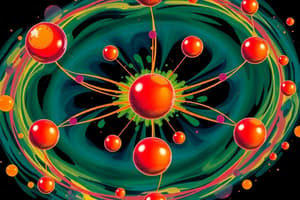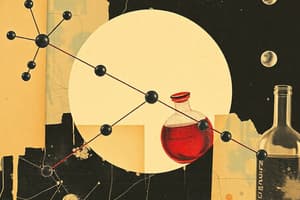Podcast
Questions and Answers
What is a characteristic of gas molecules as described by the Kinetic Molecular Theory?
What is a characteristic of gas molecules as described by the Kinetic Molecular Theory?
- Gas molecules have significant volume compared to their container.
- Gas molecules are in constant, random motion. (correct)
- Collisions between gas molecules result in energy loss.
- Gas molecules are in fixed positions.
Which type of intermolecular force is the strongest among the following?
Which type of intermolecular force is the strongest among the following?
- Hydrogen Bonds (correct)
- Van der Waals Forces
- Dipole-Dipole Forces
- Dispersion Forces
Which unit is used to express molarity?
Which unit is used to express molarity?
- g/100g
- mol/kg
- g/mL
- mol/L (correct)
What is the first step in solving a solution stoichiometry problem?
What is the first step in solving a solution stoichiometry problem?
How are dispersion forces affected by the size of the molecule?
How are dispersion forces affected by the size of the molecule?
What concentration unit is defined as the number of moles of solute per kilogram of solvent?
What concentration unit is defined as the number of moles of solute per kilogram of solvent?
In the context of solution stoichiometry, what is a key consideration when multiple reactants are involved?
In the context of solution stoichiometry, what is a key consideration when multiple reactants are involved?
Which of the following options is associated with calculating moles of a substance?
Which of the following options is associated with calculating moles of a substance?
What does molality (m) measure in a solution?
What does molality (m) measure in a solution?
Which formula is used to calculate mass percent concentration?
Which formula is used to calculate mass percent concentration?
In the stoichiometric calculation A + 2B → C, how many moles of A are needed for 3 moles of B?
In the stoichiometric calculation A + 2B → C, how many moles of A are needed for 3 moles of B?
How do you convert the concentration of a solution from molarity to moles?
How do you convert the concentration of a solution from molarity to moles?
What is the definition of parts per million (ppm) in a solution?
What is the definition of parts per million (ppm) in a solution?
Which step is NOT part of the solution stoichiometry computation process?
Which step is NOT part of the solution stoichiometry computation process?
When calculating the volume percent of a solution, what parameters are needed?
When calculating the volume percent of a solution, what parameters are needed?
Which of the following statements about concentration is correct?
Which of the following statements about concentration is correct?
What is the appropriate formula for calculating parts per billion (ppb)?
What is the appropriate formula for calculating parts per billion (ppb)?
If you have a 2 L solution with a molarity of 0.75 M, how many moles of solute are present?
If you have a 2 L solution with a molarity of 0.75 M, how many moles of solute are present?
Flashcards are hidden until you start studying
Study Notes
Kinetic Molecular Model and Intermolecular Forces
-
Kinetic Molecular Theory (KMT):
- Gases consist of a large number of molecules that are in constant, random motion.
- The volume of gas molecules is negligible compared to the volume of the container.
- Collisions between gas molecules are elastic (no energy lost).
- The average kinetic energy of gas molecules is directly proportional to the temperature (in Kelvin).
-
Intermolecular Forces (IMFs):
- Forces of attraction or repulsion between molecules.
- Types of IMFs:
- Dispersion Forces (London Forces): Present in all molecules; stronger in larger, more polarizable molecules.
- Dipole-Dipole Forces: Occur between polar molecules; stronger than dispersion forces.
- Hydrogen Bonds: A type of dipole-dipole interaction; occurs between H and highly electronegative atoms (N, O, F).
- IMFs influence physical properties such as boiling point, melting point, and viscosity.
Concentration of Solution
-
Definition: Concentration refers to the amount of solute in a given volume of solution.
-
Common Units:
- Molarity (M): Moles of solute per liter of solution (mol/L).
- Molality (m): Moles of solute per kilogram of solvent (mol/kg).
- Percent Concentration:
- Weight/Volume (% w/v): grams of solute per 100 mL of solution.
- Volume/Volume (% v/v): mL of solute per 100 mL of solution.
- Weight/Weight (% w/w): grams of solute per 100 grams of solution.
-
Calculating Molarity:
- M = moles of solute / liters of solution
- To find moles: moles = mass (g) / molar mass (g/mol).
Solution Stoichiometry
-
Definition: The study of the quantitative relationships in chemical reactions involving solutions.
-
Steps in Solution Stoichiometry:
- Write the balanced chemical equation for the reaction.
- Convert given quantities (mass, volume) to moles.
- Use mole ratios from the balanced equation to find moles of the desired substance.
- Convert moles back to mass or volume as needed.
-
Important Considerations:
- Ensure the solution concentration is known (Molarity).
- Use appropriate units for volume and mass.
- Pay attention to limiting reactants in reactions involving multiple reactants.
Kinetic Molecular Model and Intermolecular Forces
-
Kinetic Molecular Theory (KMT) describes gases as collections of molecules in perpetual random motion.
-
The volume occupied by gas molecules is insignificant relative to the entire volume of their container.
-
Gas molecules collide elastically, meaning total kinetic energy remains constant during interactions.
-
The temperature of a gas (measured in Kelvin) directly correlates with the average kinetic energy of its molecules.
-
Intermolecular Forces (IMFs) are attractions or repulsions that occur between molecules and significantly affect physical properties.
-
Dispersion Forces (London Forces) exist in all molecules; they increase in strength with larger, more polarizable molecules.
-
Dipole-Dipole Forces are present between polar molecules and are stronger than dispersion forces.
-
Hydrogen Bonds, a specific type of dipole-dipole interaction, happen between hydrogen and highly electronegative atoms like nitrogen, oxygen, or fluorine.
-
IMFs play a crucial role in determining boiling and melting points as well as viscosity of substances.
Concentration of Solution
-
Concentration quantifies the amount of solute present in a given volume of solvent or solution.
-
Common Units of Concentration include:
- Molarity (M) measures moles of solute per liter of solution (mol/L).
- Molality (m) measures moles of solute per kilogram of solvent (mol/kg).
- Percent Concentration is represented in various forms:
- Weight/Volume (% w/v) indicates grams of solute per 100 mL of solution.
- Volume/Volume (% v/v) shows mL of solute per 100 mL of solution.
- Weight/Weight (% w/w) specifies grams of solute per 100 grams of solution.
-
Calculating Molarity (M) involves the formula:
- M = moles of solute / liters of solution.
- To determine moles of solute, the equation used is moles = mass (g) / molar mass (g/mol).
Solution Stoichiometry
-
Solution stoichiometry focuses on the quantitative relationships in chemical reactions where solutions are involved.
-
Key steps in solution stoichiometry include:
- Writing a balanced chemical equation for the reaction.
- Converting given quantities (mass or volume) to moles.
- Using mole ratios from the balanced equation to calculate moles of the target substance.
- Converting moles back to mass or volume to fulfill requirements.
-
Important Considerations for solution stoichiometry:
- The concentration of the solution must be known (expressed in molarity).
- Use appropriate units for both volume and mass during calculations.
- Be mindful of limiting reactants in reactions involving multiple substances.
Concentration of Solution
- Concentration measures the amount of solute in a specified volume of solution.
- Molarity (M): Expressed in moles per liter of solution.
- Molality (m): Expressed in moles per kilogram of solvent.
- Mass Percent: Calculated as (mass of solute / mass of solution) × 100.
- Volume Percent: Determined by (volume of solute / volume of solution) × 100.
- Parts Per Million (ppm): Represents mass of solute per million parts of solution, calculated as (mass of solute / mass of solution) × 10^6.
- Parts Per Billion (ppb): Represents mass of solute per billion parts of solution, calculated as (mass of solute / mass of solution) × 10^9.
Solution Stoichiometry Computation
- Stoichiometry involves calculating reactants and products in chemical reactions based on balanced equations.
- Key Steps:
- Start by ensuring the chemical equation is balanced.
- Convert volume of solution to moles of solute using molarity (moles = Molarity (M) × Volume (L)).
- Apply mole ratios derived from the balanced equation to relate reactants and products.
- Use the mole ratios to calculate moles of the desired substance.
- Convert moles back to concentration or mass as required.
- Example Calculation: For the reaction A + 2B → C with 0.5 M of B in 2 L of solution, moles of B calculated as 1 mol. Using the mole ratio, 0.5 mol of A is needed.
- Consider the limitations of reactions, ensuring they either complete or reach an equilibrium state when applicable.
Studying That Suits You
Use AI to generate personalized quizzes and flashcards to suit your learning preferences.




